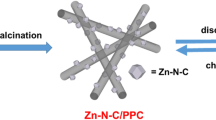Abstract
Sodium ion (Na+) batteries have attracted increased attention for energy storage owing to the natural abundance and low cost of sodium. Herein, we report the synthesis of mesoporous carbon with large pores as anode for Na-ion batteries. The mesoporous carbon was obtained by carbonization and dense packing of 50 nm resorcinol and formaldehyde spheres synthesized through an extension Stöber method. Our work demonstrates that replacement of lithium by sodium using large pore carbon as anode might offer an alternative route for rechargeable batteries.



Similar content being viewed by others
References
Slater MD, Kim D, Lee HE et al (2013) Sodium-ion batteries. Adv Funct Mater 23:947–958
Arico AS, Bruce P, Scrosati B et al (2005) Nanostructured materials for advanced energy conversion and storage devices. Nat Mater 4:366–377
Sun YK, Chen ZH, Noh HJ et al (2012) Nanostructured high-energy cathode materials for advanced lithium batteries. Nat Mater 11:942–947
Tang K, Fu LJ, White RJ et al (2012) Hollow carbon nanospheres with superior rate capability for sodium-based batteries. Adv Energy Mater 2:873–877
Wenzel S, Hara T, Janek J et al (2011) Room-temperature sodium-ion batteries: improving the rate capability of carbon anode materials by templating strategies. Energy Environ Sci 4:3342–3345
Cao YL, Xiao LF, Sushko ML et al (2013) Sodium ion insertion in hollow carbon nanowires for battery applications. Nano Lett 12:3783–3787
Alcantara R, Lavela P, Ortiz GF et al (2005) Carbon microspheres obtained from resorcinol–formaldehyde as high-capacity electrodes for sodium-ion batteries. Electrochem Solid-State Lett 8:A222–A225
Fang Y, Gu D, Zou Y et al (2010) A low-concentration hydrothermal synthesis of biocompatible ordered mesoporous carbon nanospheres with tunable and uniform size. Angew Chem Int Ed 49:7987–7991
Lu AH, Li WC, Hao GP et al (2010) Easy synthesis of hollow polymer, carbon, and graphitized microspheres. Angew Chem Int Ed 49:1615–1618
Lee J, Kim J, Hyeon T (2006) Recent progress in the synthesis of porous carbon materials. Adv Mater 18:2073–2094
Liang CD, Li ZJ, Dai S (2008) Mesoporous carbon materials: synthesis and modification. Angew Chem Int Ed 47:3696–3717
Liu J, Qiao SZ, Liu H et al (2011) Extension of the Stober method to the preparation of monodisperse resorcinol–formaldehyde resin polymer and carbon spheres. Angew Chem Int Ed 50:5947–5951
Lu AH, Hao GP, Sun Q (2011) Can carbon spheres be created through the Stober method? Angew Chem Int Ed 50:9023–9025
Choma J, Jamiola D, Augustynek K et al (2012) New opportunities in Stober synthesis: preparation of microporous and mesoporous carbon spheres. J Mater Chem 22:12636–12642
Li N, Zhang Q, Liu J et al (2013) Sol–gel coating of inorganic nanostructures with resorcinol–formaldehyde resin. Chem Commun 49:5135–5137
Yang TY, Liu J, Zheng Y et al (2013) Facile fabrication of core–shell structured Ag@Carbon and mesoporous yolk–shell structured Ag@Carbon@Silica by an extended Stöber method. Chem Eur J 19:6942–6945
Su FB, Poh CK, Chen JS et al (2011) Nitrogen-containing microporous carbon nanospheres with improved capacitive properties. Energy Environ Sci 4:717–724
Liu J, Yang TY, Wang DW et al (2013) A facile soft-template synthesis of mesoporous polymeric and carbonaceous nanospheres. Nat Commun 4:2798
Suzuki K, Ikari K, Imai H (2004) Synthesis of silica nanoparticles having a well-ordered mesostructure using a double surfactant system. J Am Chem Soc 126:462–463
Tang J, Zhou XF, Zhao DY et al (2007) Hard-sphere packing and icosahedral assembly in the formation of mesoporous materials. J Am Chem Soc 129:9044–9048
Acknowledgments
This work was supported by the Australian Research Council (ARC) Discovery Project Program. Jian Liu gratefully acknowledges the award of UQ Foundation Research Excellence Awards and a UQ Early-Career-Research Grant. Hao Liu would like to thank the support from UTS Chancellor’s Post Doctoral Fellowship (CPDF).
Author information
Authors and Affiliations
Corresponding authors
Additional information
SPECIAL ISSUE: Advanced Materials for Clean Energy
About this article
Cite this article
Liu, J., Liu, H., Yang, T. et al. Mesoporous carbon with large pores as anode for Na-ion batteries. Chin. Sci. Bull. 59, 2186–2190 (2014). https://doi.org/10.1007/s11434-014-0164-2
Received:
Accepted:
Published:
Issue Date:
DOI: https://doi.org/10.1007/s11434-014-0164-2




